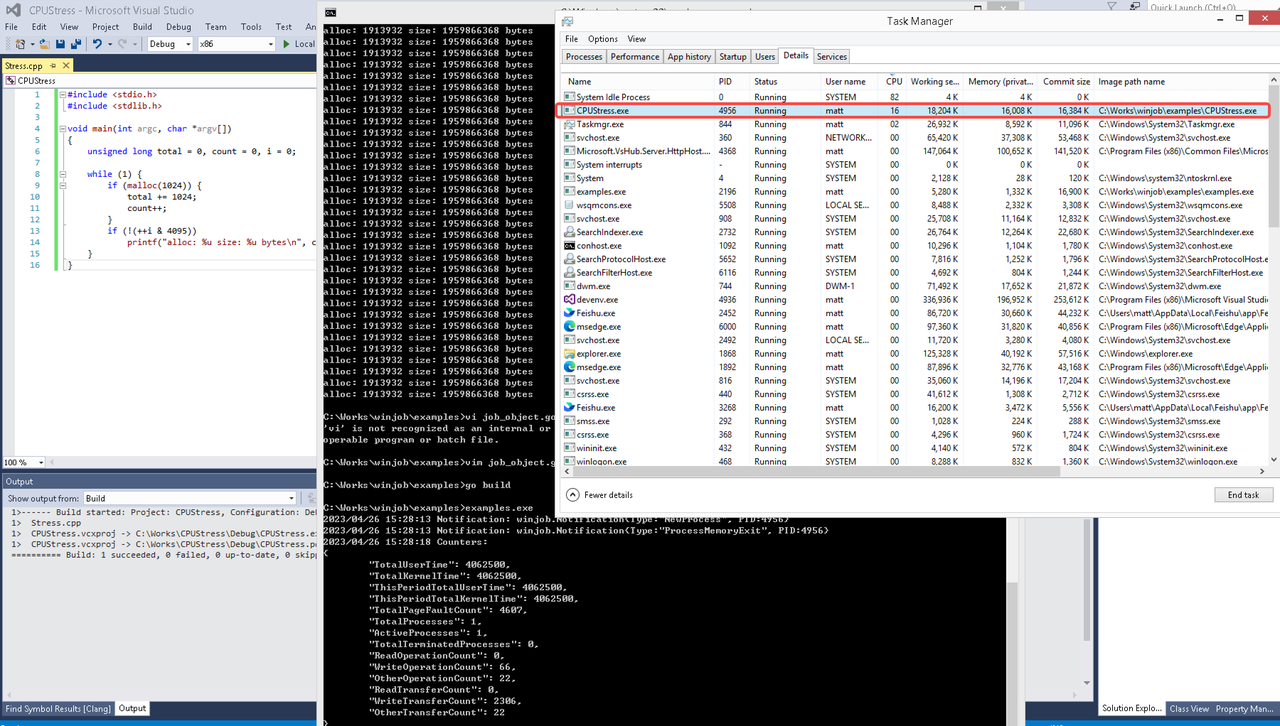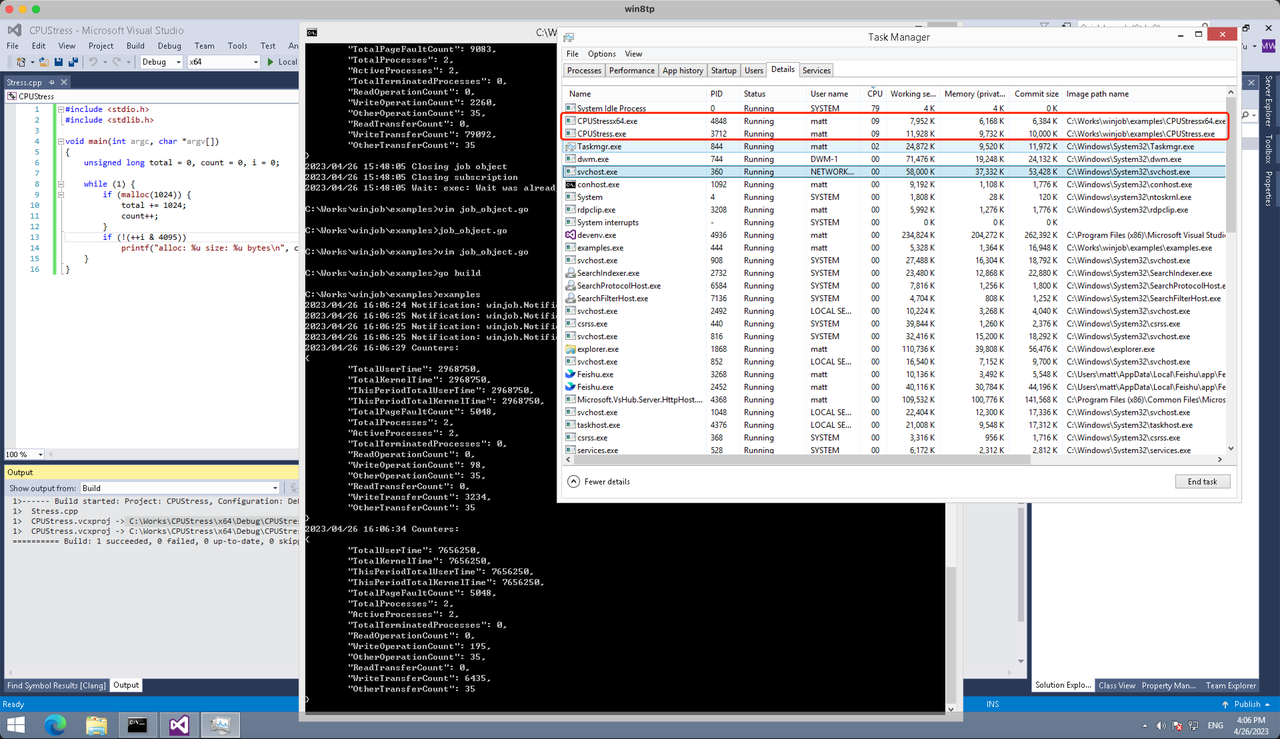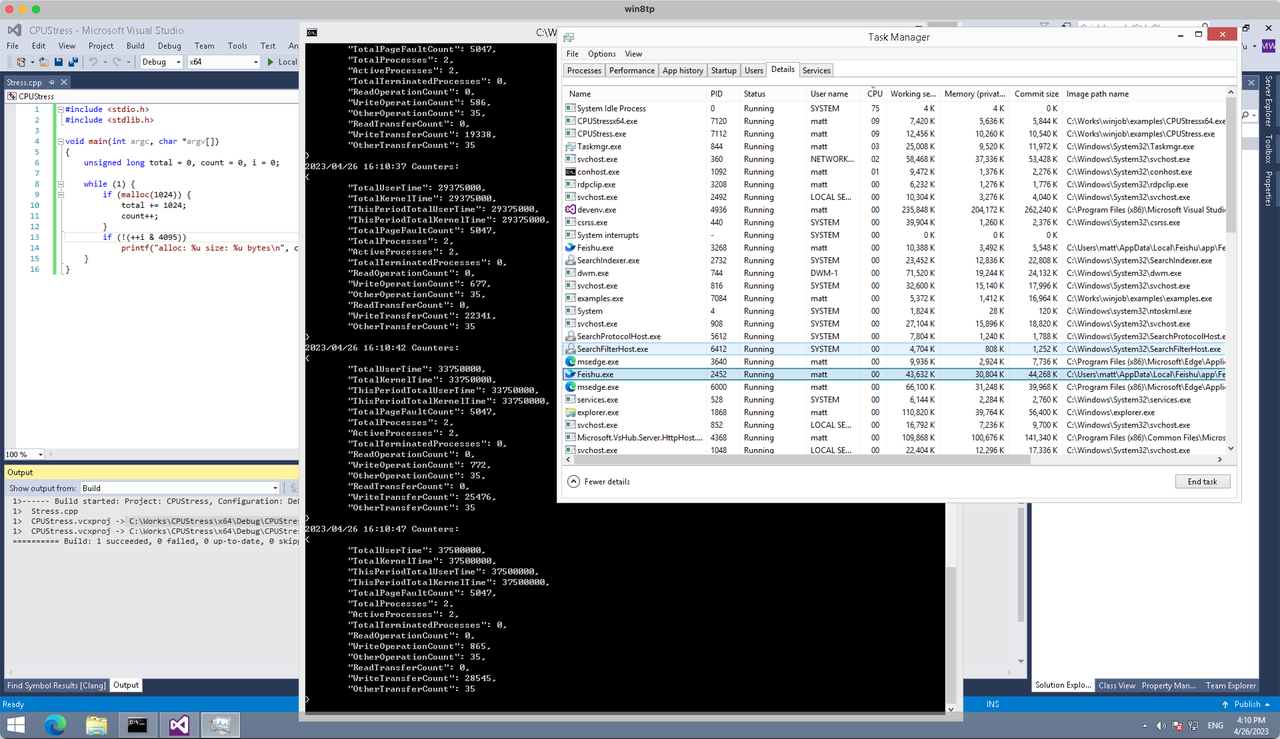Windows自身没有提供类似Linux cgroup的能力来限制进程或进程组的资源占用,进程CPU/IO/内存/网络等资源的控制只能由自己实现。目前已有第三方的实现,主要是限制进程CPU的占用,如文档 < 21 Best Ways to Limit the CPU Usage of a Process > 所描述的BES,Process Tamer等软件。自Windows 8及Server 2012开始Windows系统有提供以job为单位的CPU占用及内存上限设置,之前的版本则只能以进程或线程为单位进行限制。
进程CPU占用限制方案
即时轮询系统所有进程(线程)的CPU占用,当发现所设定进程有超标时强制暂停进程所有线程的执行,然后在适当的时机再恢复执行。其中所涉及技术点:
进程CPU占用查询 GetProcessTimes
BOOL GetProcessTimes(
[in] HANDLE hProcess,
[out] LPFILETIME lpCreationTime,
[out] LPFILETIME lpExitTime,
[out] LPFILETIME lpKernelTime,
[out] LPFILETIME lpUserTime
);此函数可以获取进程从创建至当前的总运行时间及总的CPU时间,(KernelTime + UserTime) < 系统CPU数 * (当前时间 - CreationTime)
线程CPU占用查询 GetThreadTimes
BOOL GetThreadTimes(
[in] HANDLE hThread,
[out] LPFILETIME lpCreationTime,
[out] LPFILETIME lpExitTime,
[out] LPFILETIME lpKernelTime,
[out] LPFILETIME lpUserTime
);QueryThreadCycleTime可以提供更精准的CPU时间数据,单位为CPU时钟周期
BOOL QueryThreadCycleTime(
[in] HANDLE ThreadHandle,
[out] PULONG64 CycleTime
);线程暂停及恢复
Windows平台没有提供暂停整个进程的支持函数,只能以线程为单位来操作,即SuspendThread及ResumeThread:
DWORD SuspendThread(
[in] HANDLE hThread
);
DWORD ResumeThread(
[in] HANDLE hThread
);CPU亲和性设置: SetProcessAffinityMask
BOOL SetProcessAffinityMask(
[in] HANDLE hProcess,
[in] DWORD_PTR dwProcessAffinityMask
);此函数可以限定进程及其所有线程所能使用的CPU,故一定程序上亦限定了进程最大的系统CPU占用率。
DWORD_PTR SetThreadAffinityMask(
[in] HANDLE hThread,
[in] DWORD_PTR dwThreadAffinityMask
);此函数可单独限制特定线程的CPU亲和性。
进程优先级设置: SetPriorityClass
优先级解决的是优先运行及退让CPU的问题,本质上并不能限定CPU占用,只是优先级高于当前任务的忙碌的时候,当前进程会主动退让CPU 线程优先级设置:SetThreadPriority
BOOL SetThreadPriority(
[in] HANDLE hThread,
[in] int nPriority
);Job Objects
Windows系统提供了Job的概念用以管理多个进程,可以限制Job对象内所有进程及期线程的CPU核心占用、CPU占用及内存分配上限等,均通过SetInformationJobObject来实现,具体的CPU限制由JOBOBJECT_CPU_RATE_CONTROL_INFORMATION管理,内存限制则由JOBOBJECT_EXTENDED_LIMIT_INFORMATION来管理。
BOOL SetInformationJobObject(
[in] HANDLE hJob,
[in] JOBOBJECTINFOCLASS JobObjectInformationClass,
[in] LPVOID lpJobObjectInformation,
[in] DWORD cbJobObjectInformationLength
);需要注意的是CPU占用设置只有Windows 8及Server 2012之后的版本有效。
CPU Sets
此部分只限定了CPU Affinity属性
实验验证
可以直接利用开源项目go-winjob验证,验证系统Windows 8 x64,go-winjob git repo: https://github.com/kolesnikovae/go-winjob
验证程序
#include <stdio.h>
#include <stdlib.h>
void main(int argc, char *argv[])
{
unsigned long total = 0, count = 0, i = 0;
while (1) {
if (malloc(1024)) {
total += 1024;
count++;
}
if (!(++i & 4095))
printf("alloc: %u size: %u bytes\n", count, total);
}
}无限制
在无限制的情况下,此进程会占满一个CPU核心,commit内存总占用达2G

单一进程
在设定CPU上限16%及内存16M上限之后,结果如下:
 examples/job_object.go按如下修改:
examples/job_object.go按如下修改:
var limits = []winjob.Limit{
winjob.WithBreakawayOK(),
winjob.WithKillOnJobClose(),
winjob.WithActiveProcessLimit(3),
winjob.WithProcessTimeLimit(10 * time.Second),
winjob.WithCPUHardCapLimit(1600), // 16%
winjob.WithProcessMemoryLimit(16 << 20), // 16MB
winjob.WithWriteClipboardLimit(),
}
const defaultCommand = ".\\CPUStress.exe"多进程(双进程)
将winjob.WithProcessMemoryLimit 改为 winjob.WithJobMemoryLimit,后者表示此job内所有进程要占用的总内存限制:
var limits = []winjob.Limit{
winjob.WithBreakawayOK(),
winjob.WithKillOnJobClose(),
winjob.WithActiveProcessLimit(3),
winjob.WithProcessTimeLimit(10 * time.Second),
winjob.WithCPUHardCapLimit(1600), // 16%
winjob.WithJobMemoryLimit(16 << 20), // 16MB
winjob.WithWriteClipboardLimit(),
}验证结果如下:


winjob example代码:
// +build windows
package main
import (
"encoding/json"
"log"
"os"
"os/exec"
"os/signal"
"time"
"golang.org/x/sys/windows"
"github.com/kolesnikovae/go-winjob"
)
var limits = []winjob.Limit{
winjob.WithBreakawayOK(),
winjob.WithKillOnJobClose(),
winjob.WithActiveProcessLimit(3),
winjob.WithProcessTimeLimit(10 * time.Second),
winjob.WithCPUHardCapLimit(1600), // 16%
winjob.WithJobMemoryLimit(16 << 20), // 16MB
winjob.WithWriteClipboardLimit(),
}
const defaultCommand = ".\\CPUStress.exe"
const stressCommand = ".\\CPUStressX64.exe"
func main() {
job, err := winjob.Create("", limits...)
if err != nil {
log.Fatalf("Create: %v", err)
}
cmd := exec.Command(defaultCommand)
cmd.Stderr = os.Stderr
cmd.SysProcAttr = &windows.SysProcAttr{
CreationFlags: windows.CREATE_SUSPENDED,
}
if err := cmd.Start(); err != nil {
log.Fatalf("Start: %v", err)
}
stress := exec.Command(stressCommand)
stress.Stderr = os.Stderr
stress.SysProcAttr = &windows.SysProcAttr{
CreationFlags: windows.CREATE_SUSPENDED,
}
if err := stress.Start(); err != nil {
log.Fatalf("Start: %v", err)
}
s := make(chan os.Signal, 1)
signal.Notify(s, os.Interrupt)
c := make(chan winjob.Notification)
subscription, err := winjob.Notify(c, job)
if err != nil {
log.Fatalf("Notify: %v", err)
}
done := make(chan struct{})
go func() {
defer close(done)
ticker := time.NewTicker(time.Second * 5)
defer ticker.Stop()
var counters winjob.Counters
for {
select {
case <-s:
log.Println("Closing job object")
if err := job.Close(); err != nil {
log.Fatal(err)
}
log.Println("Closing subscription")
if err := subscription.Close(); err != nil {
log.Fatal(err)
}
return
case n, ok := <-c:
if ok {
log.Printf("Notification: %#v\n", n)
} else if err := subscription.Err(); err != nil {
log.Fatalf("Subscription: %v", err)
}
case <-ticker.C:
if err := job.QueryCounters(&counters); err != nil {
log.Fatalf("QueryCounters: %v", err)
}
b, err := json.MarshalIndent(counters, "", "\t")
if err != nil {
log.Fatal(err)
}
log.Printf("Counters: \n%s\n", b)
}
}
}()
if err := job.Assign(cmd.Process); err != nil {
log.Fatalf("Assign: %v", err)
}
if err := winjob.Resume(cmd); err != nil {
log.Fatalf("Resume: %v", err)
}
if err := job.Assign(stress.Process); err != nil {
log.Fatalf("Assign: %v", err)
}
if err := winjob.Resume(stress); err != nil {
log.Fatalf("Resume: %v", err)
}
if err := cmd.Wait(); err != nil {
log.Fatalf("Wait: %v", err)
}
if err := stress.Wait(); err != nil {
log.Fatalf("Wait: %v", err)
}
// Wait for a signal.
<-done
}
App reliable
http://1x-bet-casino.in/1xbet-on-android/
Push alerts for odds changes, helpful for betting
how to install pin-up games app
Loyalty rewards feel genuine and useful
pin-up casino bd promo code
Interface user-friendly for beginners.
how to install jokabet app
Услуги таможенного брокера москва — 10 из 10
https://compartomisrecetas.com/@kennithgamez5?page=about
This app is fantastic! Super easy to download and install on Android, and it runs smoothly without any lags. Love the quick access to slots and live betting.
get the app
натяжной потолок самара [url=https://natyazhnye-potolki-samara-5.ru]https://natyazhnye-potolki-samara-5.ru[/url] .
App is lightweight at 55MB – doesn’t take much space but packs full functionality.
jokabet mobile app review
Московская Академия Бильярда — это место, где за три занятия можно научиться уверенно держать кий и обыгрывать друзей, благодаря авторской методике Ярослава Гладского. Тренеры с опытом более восьми лет работают индивидуально и в группах, создавая тёплую атмосферу и быстрый прогресс. Записаться на уроки, узнать расписание и тарифы удобно на https://billiardmsk.ru/ — здесь есть программы для взрослых, детей и корпоративные форматы обучения.
Big multipliers hit often. Thrilling wins.
jokabet mobile app review
App feels faster than browser version. Preloaded graphics make a difference. https://jokabetapp.com/app
онлайн школа ломоносов [url=https://shkola-onlajn5.ru/]онлайн школа ломоносов[/url] .
Таможенное оформление в домодедово москва — быстро и удобно
https://friztty.com/@silkejuergens5
onlyfans leaks
live XXX cams
shemale porn
потолочек ру [url=http://natyazhnye-potolki-samara-8.ru/]http://natyazhnye-potolki-samara-8.ru/[/url] .
потолочников натяжные потолки [url=http://natyazhnye-potolki-samara-7.ru]http://natyazhnye-potolki-samara-7.ru[/url] .
проект перепланировки квартиры [url=http://www.zakazat-proekt-pereplanirovki-kvartiry1.ru]проект перепланировки квартиры[/url] .
potolochkin ru [url=https://natyazhnye-potolki-nizhniy-novgorod-6.ru/]https://natyazhnye-potolki-nizhniy-novgorod-6.ru/[/url] .
Таможенное оформление экспорт москва — сроки соблюдены
https://git.imvictor.tech:2/zenaidademaine/zenaida1992/wiki/tamozhennoe-oformlenie+71v.-
потолочкин ру натяжные потолки [url=www.natyazhnye-potolki-samara-6.ru]www.natyazhnye-potolki-samara-6.ru[/url] .
потолочкин отзывы нижний новгород [url=https://www.natyazhnye-potolki-nizhniy-novgorod-7.ru]https://www.natyazhnye-potolki-nizhniy-novgorod-7.ru[/url] .
chinese gay porn
Best Porn Games
Best Gay site porn
согласование перепланировки квартиры цена [url=http://www.skolko-stoit-uzakonit-pereplanirovku-4.ru]согласование перепланировки квартиры цена[/url] .